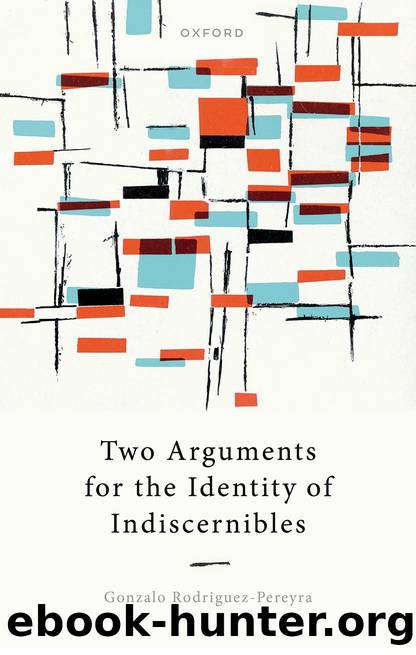Two Arguments for the Identity of Indiscernibles by Gonzalo Rodriguez-Pereyra;

Author:Gonzalo Rodriguez-Pereyra; [Rodriguez-Pereyra, Gonzalo]
Language: eng
Format: epub
ISBN: 9780192692344
Publisher: Oxford University Press USA
Published: 2022-08-11T00:00:00+00:00
Two Arguments for the Identity of Indiscernibles. Gonzalo Rodriguez-Pereyra, Oxford University Press. © Gonzalo Rodriguez-Pereyra 2022. DOI: 10.1093/oso/9780192866868.003.0004
1 Thus, bare particulars have properties, despite the common assertion that they donât. That they have properties on my conception of properties as predicable conditions should be obvious. But even on a conception of properties as concrete universals they should be conceived as having properties. Indeed, discussing bare particulars in the context of such a theory of universals, Sider argues that bare particulars may be red, round, and juicy (Sider 2006: 388). Of course, having such universals would make bare particulars concrete objects, while I am here assuming, for the sake of argument, that they are abstract objects. Despite this difference, the point stands: bare particulars have properties.
2 Must the spheres have parts? A world like Blackâs but in which the spheres are extended simples seems to be a possible one. In fact, I have argued that one of Leibnizâs arguments for the Identity of Indiscernibles fails precisely because the argument is unable to rule out a world like Blackâs containing two simple indiscernible objects, whether or not they are extended indiscernible simples (Rodriguez-Pereyra 2014: 108â16). Now, since extended simples are more controversial than extended complexes, the difference in dialectical situation is a relevant difference. If one is trying to refute an argument for a version of the Identity of Indiscernibles, which is what I was trying to do in the book on Leibniz I just cited, it is sufficient to appeal to a world of simples, leaving open whether such simples are extended; but if one is trying to establish the falsity of a version of the Identity of Indiscernibles, which is what I shall do in the next chapter, one should aspire to more than merely assuming the possibility of extended simples and then establish the possibility of a world with two indiscernible extended simples. Thus, I shall establish the possibility of a world with two indiscernible complex spheres, spheres having proper parts.
3 That the spheres in Blackâs world do not bear any causal relations to each other is not essential to the philosophical significance of Blackâs world, namely refuting PIIa. The spheres could be causally related to each other in several ways, provided they were symmetrically causally related and neither was causally related to itself in a way the other one was not causally related to itselfâin that case no difference in pure properties would arise from these causal relations. But note that if the spheres are causally related, causation must be a primitive relation, not accountable in terms of differences in pure properties or spatiotemporal relations. For a discussion of primitive causation relevant to the present topic, see Audi 2011.
4 Three clarificatory points. First, although Goodman speaks of qualitative properties rather than pure properties, his qualitative properties are my pure properties (see Goodman 2015: 1, fn. 1). Second, Goodman assumes that the spheres in Blackâs world are orbiting each other, and so the property he considers is being a
Download
This site does not store any files on its server. We only index and link to content provided by other sites. Please contact the content providers to delete copyright contents if any and email us, we'll remove relevant links or contents immediately.
| Applied | Geometry & Topology |
| History | Infinity |
| Mathematical Analysis | Matrices |
| Number Systems | Popular & Elementary |
| Pure Mathematics | Reference |
| Research | Study & Teaching |
| Transformations | Trigonometry |
Weapons of Math Destruction by Cathy O'Neil(5068)
Factfulness: Ten Reasons We're Wrong About the World – and Why Things Are Better Than You Think by Hans Rosling(4038)
Factfulness_Ten Reasons We're Wrong About the World_and Why Things Are Better Than You Think by Hans Rosling(2764)
Descartes' Error by Antonio Damasio(2755)
A Mind For Numbers: How to Excel at Math and Science (Even If You Flunked Algebra) by Barbara Oakley(2699)
TCP IP by Todd Lammle(2655)
Applied Predictive Modeling by Max Kuhn & Kjell Johnson(2499)
Fooled by Randomness: The Hidden Role of Chance in Life and in the Markets by Nassim Nicholas Taleb(2429)
The Book of Numbers by Peter Bentley(2419)
The Tyranny of Metrics by Jerry Z. Muller(2417)
The Great Unknown by Marcus du Sautoy(2200)
Once Upon an Algorithm by Martin Erwig(2157)
Easy Algebra Step-by-Step by Sandra Luna McCune(2134)
Practical Guide To Principal Component Methods in R (Multivariate Analysis Book 2) by Alboukadel Kassambara(2102)
Lady Luck by Kristen Ashley(2086)
Police Exams Prep 2018-2019 by Kaplan Test Prep(2045)
Linear Time-Invariant Systems, Behaviors and Modules by Ulrich Oberst & Martin Scheicher & Ingrid Scheicher(1989)
All Things Reconsidered by Bill Thompson III(1968)
Secrets of Creation, Volume 1: The Mystery of the Prime Numbers by Watkins Matthew(1876)
